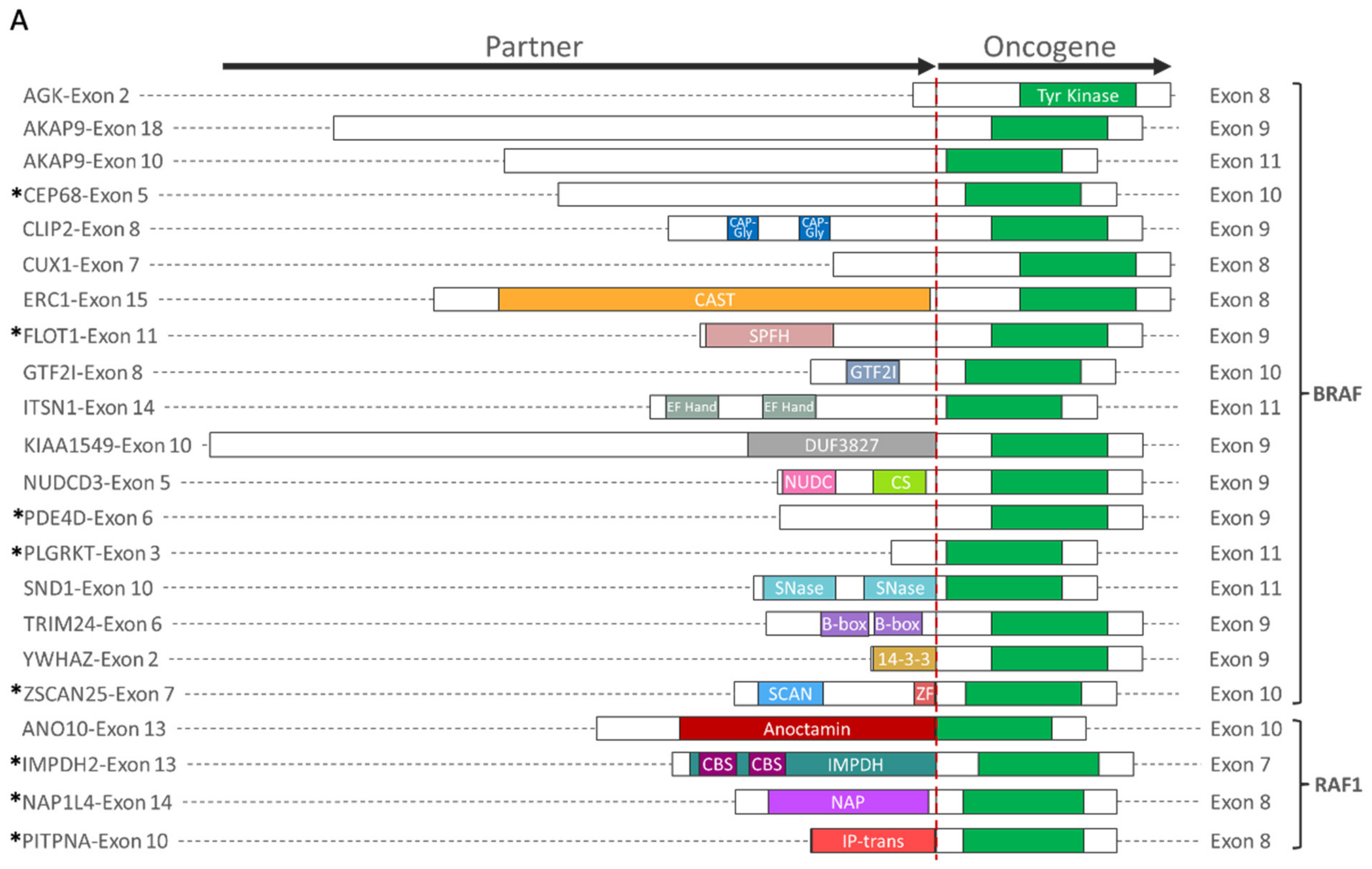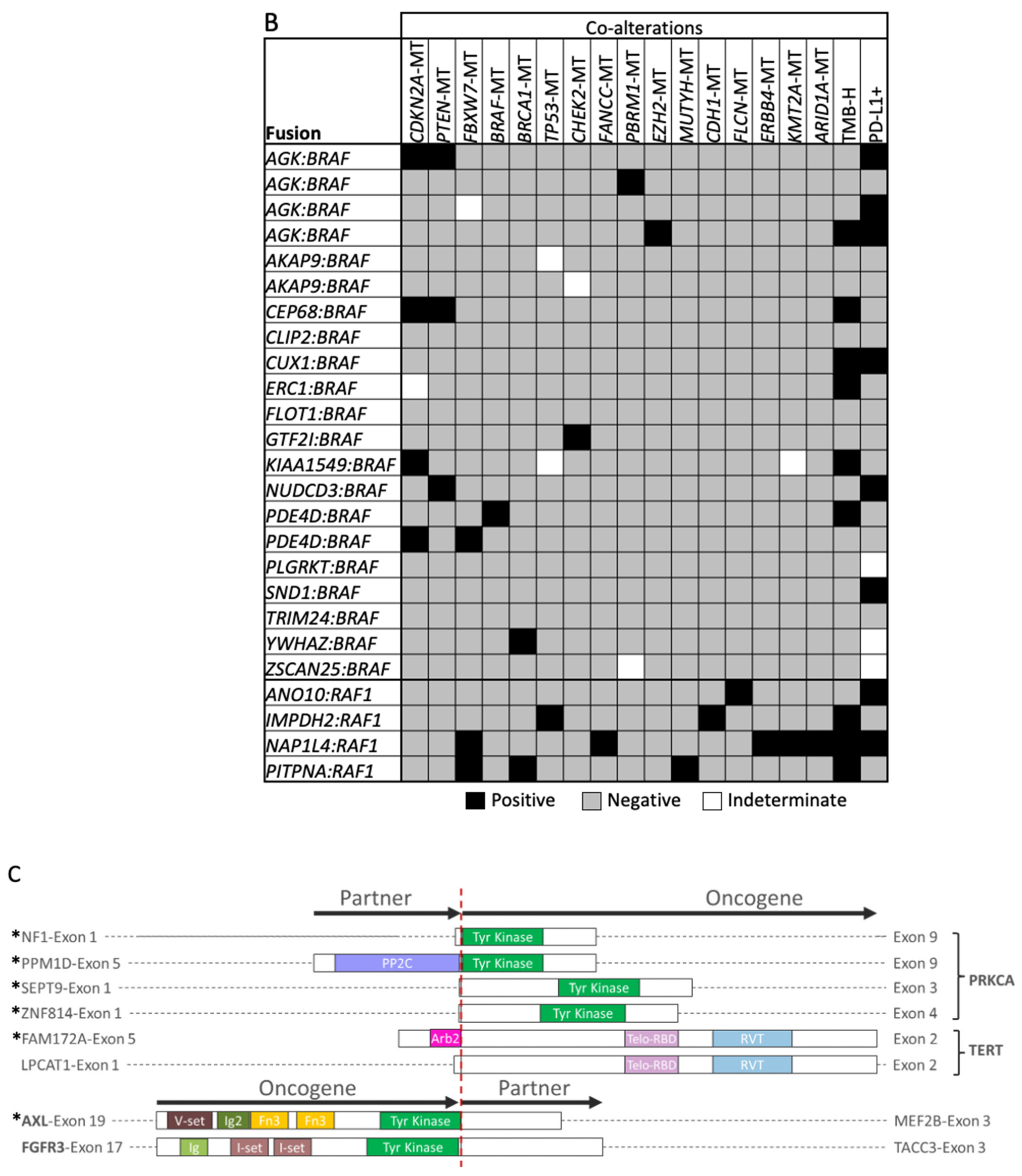Transcriptional Profiling of Malignant Melanoma Reveals Novel and Potentially Targetable Gene Fusions
Abstract
:Simple Summary
Abstract
1. Introduction
2. Materials and Methods
3. Results
3.1. Patient Cohort Characteristics
3.2. Key Pathway Alterations and Therapy-Associated Biomarkers in Fusion-Positive Tumors
3.3. Functional Domains in Oncogenic Fusions and Co-Alterations
3.4. BRAF and RAF1 Fusion-Positive Tumors Exhibit MAPK Pathway Activation in the Absence of Other Driver Alterations
3.5. Melanomas with Oncogenic Fusions Events Display Variable Signaling Pathway Activation and Tumor Immune Cell Infiltrates
4. Discussion
5. Conclusions
Supplementary Materials
Author Contributions
Funding
Institutional Review Board Statement
Informed Consent Statement
Data Availability Statement
Acknowledgments
Conflicts of Interest
References
- Quan, V.L.; Panah, E.; Zhang, B.; Shi, K.; Mohan, L.S.; Gerami, P. The role of gene fusions in melanocytic neoplasms. J. Cutan. Pathol. 2019, 46, 878–887. [Google Scholar] [CrossRef] [PubMed] [Green Version]
- Mitelman, F.; Johansson, B.; Mertens, F. The impact of translocations and gene fusions on cancer causation. Nat. Rev. Cancer 2007, 7, 233–245. [Google Scholar] [CrossRef] [PubMed]
- Suda, K.; Mitsudomi, T. Emerging oncogenic fusions other than ALK, ROS1, RET, and NTRK in NSCLC and the role of fusions as resistance mechanisms to targeted therapy. Transl. Lung Cancer Res. 2020, 9, 2618. [Google Scholar] [CrossRef] [PubMed]
- Gao, J.; Aksoy, B.A.; Dogrusoz, U.; Dresdner, G.; Gross, B.; Sumer, S.O.; Sun, Y.; Jacobsen, A.; Sinha, R.; Larsson, E.; et al. Integrative analysis of complex cancer genomics and clinical profiles using the cBioPortal. Sci. Signal. 2013, 6, pl1. [Google Scholar] [CrossRef] [Green Version]
- Cerami, E.; Gao, J.; Dogrusoz, U.; Gross, B.E.; Sumer, S.O.; Aksoy, B.A.; Jacobsen, A.; Byrne, C.J.; Heuer, M.L.; Larsson, E.; et al. The cBio cancer genomics portal: An open platform for exploring multidimensional cancer genomics data. Cancer Discov. 2012, 2, 401–404. [Google Scholar] [CrossRef] [Green Version]
- AACR Project Genie Consortium. AACR Project GENIE: Powering precision medicine through an international consortium. Cancer Discov. 2017, 7, 818–831. [Google Scholar] [CrossRef] [Green Version]
- McEvoy, C.R.; Xu, H.; Smith, K.; Etemadmoghadam, D.; San Leong, H.; Choong, D.Y.; Byrne, D.J.; Iravani, A.; Beck, S.; Mileshkin, L.; et al. Profound MEK inhibitor response in a cutaneous melanoma harboring a GOLGA4-RAF1 fusion. J. Clin. Investig. 2019, 129, 1940–1945. [Google Scholar] [CrossRef] [Green Version]
- Kim, K.B.; Semrad, T.; Schrock, A.B.; Ali, S.M.; Ross, J.S.; Singer, M.; Kashani-Sabet, M. Significant clinical response to a MEK inhibitor therapy in a patient with metastatic melanoma harboring an RAF1 fusion. JCO Precis. Oncol. 2018, 2, 1–6. [Google Scholar] [CrossRef]
- Ross, J.S.; Wang, K.; Chmielecki, J.; Gay, L.; Johnson, A.; Chudnovsky, J.; Yelensky, R.; Lipson, D.; Ali, S.M.; Elvin, J.A.; et al. The distribution of BRAF gene fusions in solid tumors and response to targeted therapy. Int. J. Cancer 2016, 138, 881–890. [Google Scholar] [CrossRef] [Green Version]
- Botton, T.; Yeh, I.; Nelson, T.; Vemula, S.S.; Sparatta, A.; Garrido, M.C.; Allegra, M.; Rocchi, S.; Bahadoran, P.; McCalmont, T.H.; et al. Recurrent BRAF kinase fusions in melanocytic tumors offer an opportunity for targeted therapy. Pigment Cell Melanoma Res. 2013, 26, 845–851. [Google Scholar] [CrossRef] [Green Version]
- Patro, R.; Duggal, G.; Love, M.I.; Irizarry, R.A.; Kingsford, C. Salmon provides fast and bias-aware quantification of transcript expression. Nat. Methods 2017, 14, 417–419. [Google Scholar] [CrossRef] [Green Version]
- Cristescu, R.; Mogg, R.; Ayers, M.; Albright, A.; Murphy, E.; Yearley, J.; Sher, X.; Liu, X.Q.; Lu, H.; Nebozhyn, M.; et al. Pan-tumor genomic biomarkers for PD-1 checkpoint blockade-based immunotherapy. Science 2018, 362, eaar3593. [Google Scholar] [CrossRef] [Green Version]
- Wagle, M.C.; Kirouac, D.; Klijn, C.; Liu, B.; Mahajan, S.; Junttila, M.; Moffat, J.; Merchant, M.; Huw, L.; Wongchenko, M.; et al. A transcriptional MAPK Pathway Activity Score (MPAS) is a clinically relevant biomarker in multiple cancer types. NPJ Precis. Oncol. 2018, 2, 7. [Google Scholar] [CrossRef] [PubMed] [Green Version]
- Marabelle, A.; Fakih, M.; Lopez, J.; Shah, M.; Shapira-Frommer, R.; Nakagawa, K.; Chung, H.C.; Kindler, H.L.; Lopez-Martin, J.A.; Miller, W.; et al. Association of tumour mutational burden with outcomes in patients with select advanced solid tumours treated with pembrolizumab in KEYNOTE-158. Ann. Oncol. 2019, 30, v477–v478. [Google Scholar] [CrossRef]
- Merino, D.M.; McShane, L.M.; Fabrizio, D.; Funari, V.; Chen, S.J.; White, J.R.; Wenz, P.; Baden, J.; Barrett, J.C.; Chaudhary, R.; et al. Establishing guidelines to harmonize tumor mutational burden (TMB): In silico assessment of variation in TMB quantification across diagnostic platforms: Phase I of the Friends of Cancer Research TMB Harmonization Project. J. Immunother. Cancer 2020, 8, e000147. [Google Scholar] [CrossRef] [Green Version]
- Williams, E.A.; Shah, N.; Montesion, M.; Sharaf, R.; Pavlick, D.C.; Sokol, E.S.; Alexander, B.M.; Venstrom, J.M.; Elvin, J.A.; Ross, J.S.; et al. Melanomas with activating RAF1 fusions: Clinical, histopathologic, and molecular profiles. Mod. Pathol. 2020, 33, 1466–1474. [Google Scholar] [CrossRef] [Green Version]
- Lin, X.; Zhang, F.; Liu, J.; Niu, Y.; Wang, C.; Li, W.; Ma, T. Genetic landscape of melanoma in China reveals enrichment of fusions in driver-negative melanoma. J. Clin. Oncol. 2021, 39, e21577. [Google Scholar] [CrossRef]
- Rankin, A.; Johnson, A.; Roos, A.; Kannan, G.; Knipstein, J.; Britt, N.; Rosenzweig, M.; Haberberger, J.; Pavlick, D.; Severson, E.; et al. Targetable BRAF and RAF1 alterations in advanced pediatric cancers. Oncology 2021, 26, e153–e163. [Google Scholar] [CrossRef]
- Kumar-Sinha, C.; Kalyana-Sundaram, S.; Chinnaiyan, A.M. Landscape of gene fusions in epithelial cancers: Seq and ye shall find. Genome Med. 2015, 7, 129. [Google Scholar] [CrossRef] [Green Version]
- Chen, R.; Manochakian, R.; James, L.; Azzouqa, A.G.; Shi, H.; Zhang, Y.; Zhao, Y.; Zhou, K.; Lou, Y. Emerging therapeutic agents for advanced non-small cell lung cancer. J. Hematol. Oncol. 2020, 13, 58. [Google Scholar] [CrossRef]
- Antonescu, C.R.; Suurmeijer, A.J.; Zhang, L.; Sung, Y.S.; Jungbluth, A.A.; Travis, W.D.; Al-Ahmadie, H.; Fletcher, C.D.; Alaggio, R. Molecular characterization of inflammatory myofibroblastic tumors with frequent ALK and ROS1 fusions and rare novel RET gene rearrangement. Am. J. Surg. Pathol. 2015, 39, 957. [Google Scholar] [CrossRef] [PubMed] [Green Version]
- Demeure, M.J.; Aziz, M.; Rosenberg, R.; Gurley, S.D.; Bussey, K.J.; Carpten, J.D. Whole-genome sequencing of an aggressive BRAF wild-type papillary thyroid cancer identified EML4–ALK translocation as a therapeutic target. World J. Surg. 2014, 38, 1296–1305. [Google Scholar] [CrossRef] [PubMed]
- Lin, E.; Li, L.; Guan, Y.; Soriano, R.; Rivers, C.S.; Mohan, S.; Pandita, A.; Tang, J.; Modrusan, Z. Exon array profiling detects EML4-ALK fusion in breast, colorectal, and non-small cell lung cancers. Mol. Cancer Res. 2009, 7, 1466–1476. [Google Scholar] [CrossRef] [Green Version]
- Stangl, C.; Post, J.B.; van Roosmalen, M.J.; Hami, N.; Verlaan-Klink, I.; Vos, H.R.; van Es, R.M.; Koudijs, M.J.; Voest, E.E.; Snippert, H.J.; et al. Diverse BRAF gene fusions confer resistance to EGFR-targeted therapy via differential modulation of BRAF activity. Mol. Cancer Res. 2020, 18, 537–548. [Google Scholar] [CrossRef] [Green Version]
- Menzies, A.M.; Yeh, I.; Botton, T.; Bastian, B.C.; Scolyer, R.A.; Long, G.V. Clinical activity of the MEK inhibitor trametinib in metastatic melanoma containing BRAF kinase fusion. Pigment Cell Melanoma Res. 2015, 28, 607. [Google Scholar] [CrossRef] [Green Version]






| Characteristic | All Cases | Fusion-Positive (P/LP) | Fusion-Positive (Unc) | Fusion-Negative |
|---|---|---|---|---|
| Total, N samples (% of total) | 1255 (100%) | 33 (2.6%) | 669 (53.3%) | 553 (44.1%) |
| Median Age, years (SD) | 67 (13.5) | 60 (16.1) | 68 (12.9) | 66 (14.0) |
| Age Range, years | 3–90 | 23–84 | 23–90 | 3–90 |
| p-value (Mann–Whitney U) | ------ | 0.0995 | 0.0071 | ------ |
| Female/Male, N cases | 478/777 | 16/17 | 277/392 | 185/368 |
| (% Female/% Male) | (38.1%/61.9%) | (48.5%/51.5%) | (41.4%/58.6%) | (33.5%/66.5%) |
| p-value (Chi-square) | ------ | 0.0772 | 0.0043 | ------ |
| Metastatic/Primary, N cases | 780/456 | 21/12 | 411/246 | 348/198 |
| (% Metastatic/% Primary) | (63.1%/36.9%) | (63.6%/36.4%) | (62.6%/37.4%) | (63.7%/36.3%) |
| N unclear | 19 | 0 | 12 | 7 |
| p-value (Chi-square) | ------ | 0.9908 | 0.673 | ------ |
Publisher’s Note: MDPI stays neutral with regard to jurisdictional claims in published maps and institutional affiliations. |
© 2022 by the authors. Licensee MDPI, Basel, Switzerland. This article is an open access article distributed under the terms and conditions of the Creative Commons Attribution (CC BY) license (https://creativecommons.org/licenses/by/4.0/).
Share and Cite
Darabi, S.; Elliott, A.; Braxton, D.R.; Zeng, J.; Hodges, K.; Poorman, K.; Swensen, J.; Shanthappa, B.U.; Hinton, J.P.; Gibney, G.T.; et al. Transcriptional Profiling of Malignant Melanoma Reveals Novel and Potentially Targetable Gene Fusions. Cancers 2022, 14, 1505. https://doi.org/10.3390/cancers14061505
Darabi S, Elliott A, Braxton DR, Zeng J, Hodges K, Poorman K, Swensen J, Shanthappa BU, Hinton JP, Gibney GT, et al. Transcriptional Profiling of Malignant Melanoma Reveals Novel and Potentially Targetable Gene Fusions. Cancers. 2022; 14(6):1505. https://doi.org/10.3390/cancers14061505
Chicago/Turabian StyleDarabi, Sourat, Andrew Elliott, David R. Braxton, Jia Zeng, Kurt Hodges, Kelsey Poorman, Jeff Swensen, Basavaraja U. Shanthappa, James P. Hinton, Geoffrey T. Gibney, and et al. 2022. "Transcriptional Profiling of Malignant Melanoma Reveals Novel and Potentially Targetable Gene Fusions" Cancers 14, no. 6: 1505. https://doi.org/10.3390/cancers14061505
APA StyleDarabi, S., Elliott, A., Braxton, D. R., Zeng, J., Hodges, K., Poorman, K., Swensen, J., Shanthappa, B. U., Hinton, J. P., Gibney, G. T., Moser, J., Phung, T., Atkins, M. B., In, G. K., Korn, W. M., Eisenberg, B. L., & Demeure, M. J. (2022). Transcriptional Profiling of Malignant Melanoma Reveals Novel and Potentially Targetable Gene Fusions. Cancers, 14(6), 1505. https://doi.org/10.3390/cancers14061505







